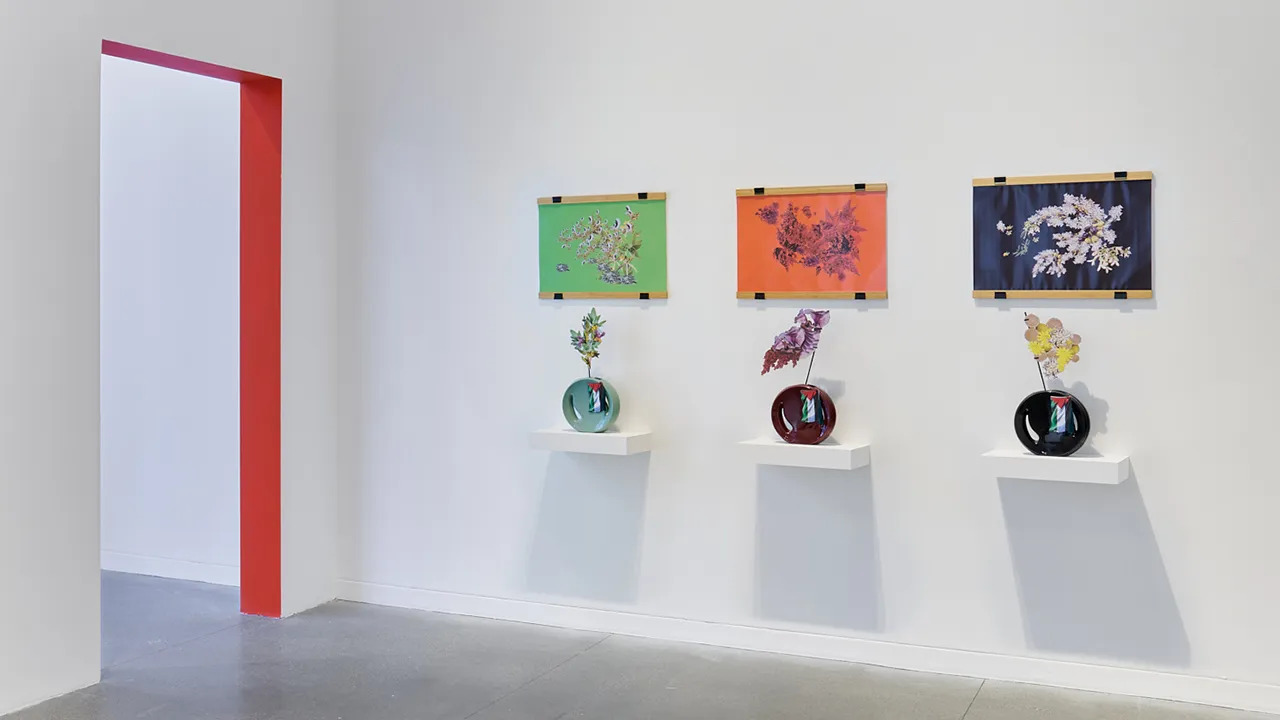Tosha Stimage has assembled an elegant triptych of three vintage ceramic vases. A single sprig of olive, sage and sumac rises out of each vase. Above the plants—all native to Israel/Palestine—are three digital collages of the same plants. The background colors of the print are black, green, and red. These are the national colors of Palestinians. This may be subtle, but the three small Palestinian flags attached to the upper right corner of each vase are not.
Perhaps this is provocative and disturbing to a Jewish viewer in a Jewish museum.
But this work, No one is listening to us, is part of an exhibition dedicated to tikkun, repair. And you can’t repair something if nothing is broken.
Now that I have acknowledged the power of Stimage, a Berkeley-based multidisciplinary artist and educator, and her work, No one is listening to us, in the exhibition Tikkun: For the Cosmos, the Community, and Ourselves at The Contemporary Jewish Museum (The CJM), I need to acknowledge The CJM. They got the exhibition title right.
The mystic Rabbi Isaac Luria (1534-1572) listened deeply to the world in which we live and put forth three big ideas:
- Tzimtzum, or “contraction.” God, who is perfection, makes room for imperfection.
- Shevirat ha-kelim, or “the shattering of the vessels.” This is the result of God making room.
- Tikkun. The “repair” or “fixing,” often referenced in the term tikkun olam (repairing the world).
Luria deduced that if the Creator is perfect and we are imperfect, then the Creator must have removed the Creator from existence to make room for us. There was breakage.
Furthermore, we have done more breakage. Yet we yearn for oneness, and strive to make repairs so that all existence will return to its perfect original condition.
There are broken pieces everywhere. It takes courage to listen and look for them, recognize them, and then, without guilt, try to make what small repairs we can.
It takes courage to show the disturbing artwork that might inspire us to do it.
 Tosha Stimage, No one is listening to us, 2022. Courtesy the artist. Photo: Impart Photography.
Tosha Stimage, No one is listening to us, 2022. Courtesy the artist. Photo: Impart Photography.
And No one is listening to us is appropriately disturbing. Seeing the images of olive, sage, and sumac, the eye is drawn to flora of the Land of Israel—and the food! Za’atar, olives, bread. Delicious and flavorful to anyone living on that land, savories claimed by everyone.
But then one sees the little Palestinian flags.
And a cascade of broken promises come to mind: Turkish and British broken promises, Israeli and Palestinian broken promises. Broken lives, families, and spirits, everywhere. It leaves a bitter taste in my mouth.
Who is the no one in No one is listening to us?
I think it is me, the unseeing observer, the unhearing listener.
The Israeli poet Yehuda Amichai turns his gaze on the observers at the end of his famous poem “Tourists”:
A group of tourists was standing around their guide and I became their target marker. “You see that man with the baskets? Just right of his head there’s an arch from the Roman period. Just right of his head.” “But he’s moving, he’s moving!” I said to myself: “redemption will come only if their guide tells them, ‘You see that arch from the Roman period? It’s not important: but next to it, left down and a bit, there sits a man who’s bought fruit and vegetables for his family.'”
Stimage makes me wonder: Am I Amichai’s tourist wearing blinders? How can I enjoy my delicious Israeli hotel breakfast? I love my Israeli family and friends, and just now, after the recent Israeli election, I am even more of a heartbroken Zionist (to be precise, a Labor Zionist, the dodo bird of contemporary Israeli politics).
I wrote this piece hours after the twenty-seventh anniversary of the assassination of Israeli Prime Minister Yitzhak Rabin. Just before he was murdered, he sang Shir le-Shalom (“Song for Peace”) in public.
He dreaded singing.
I think I dread listening.
I am grateful to The CJM for including No one is listening to us. I am trying to listen.

